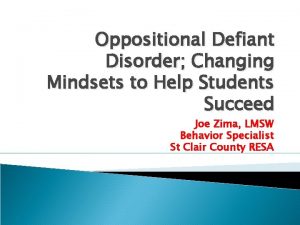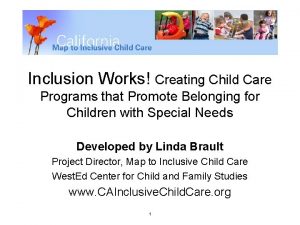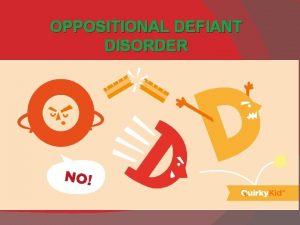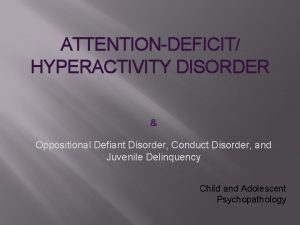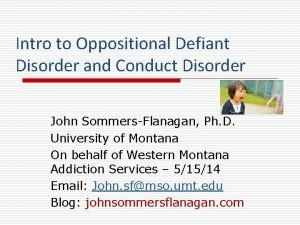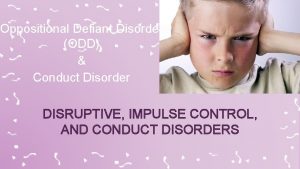Inclusion and Oppositional Defiant Disorder Creating a Learning










- Slides: 10

Inclusion and Oppositional Defiant Disorder: Creating a Learning Environment

CHD 304 - The Exceptional Child Spring 1 2016 By: Jennifer Hansen

• Oppositional Defiant Disorder is defined by persistent and repetitive behaviors such as: disobedience, opposition and disruption specifically toward those in authority. • These behaviors must be displayed for a minimum of 6 months and have significant impact of 2 or more environments i. e. school and home. • It is NOT typical, developmentally appropriate behaviors that all children exhibit. These behaviors impact the child’s well being and overall development. Some causes and risk factors: • Abuse and/or neglect • Parental history of behavioral disorders and mental health challenges • History of harsh and/or inconsistent punishment • Altering life circumstances • Significant conflict in the familial unit • Lengthy tantrums and difficult temperament. • Skill gap in self and emotional regulation. Impacts: • May have difficulty in forming positive peer relationships • Cognition level may be impacted due to excessive “acting out” and lack of presence for academics. • Distress in family and other environments and inability to build connections.

Early Intervention is Important!

Creating An Inclusive Environment: How? • Be patient • Use positive reinforcement and descriptive praise for behaviors that are appropriate • Focus on strengths rather than areas of improvement • Break directions into small, simple steps • Use a behavioral modification systems such as a chart or visual system for child to track progress. • Work closely with parents to track and monitor behaviors both at home and school • Teach skills that are lacking through task analysis • Utilize shorter sessions and a variety of learning styles • Allow child to use all senses to learn • Use Collaborative Problem Solving (Ross Greene) • Do not get into power struggles • Create a space that is conducive to taking a “break” or time away to gain control • Outline clear and consistent boundaries and limits

Collaborative Problem Solving

Behavioral/Incentive Tracking Tools

Modifications and Considerations Modification of Assignments • Allow for more time and ability to take breaks • Alter expectations for learning targets Allow personal space or environment for a “break” • Help child develop skills and recognition to modify behaviors • Help to nurture self regulation skills and allow re-group time School/Home Communication • Use a journal for communication between teachers and parents • Build trusting and valid relationships with care givers to ensure consistency of expectations and limits

Welcome Children!! *Have classroom expectations visible for all to see- in writing and in pictures *Create an environment that praises kindness *Give ample opportunity for peer relationship building *Highlight examples of appropriate peer behaviors to model classroom expectations

Welcome Parents and Families!! *Discuss preferred means of communication about child *Invite them to come in and observe or take part in classroom help opportunities *Teacher should stress accessibility and willingness to collaborate * Include parents and families in all decisions and choices about their child
 Oppositional defiant disorder in adults
Oppositional defiant disorder in adults Idea definition of emotional disturbance
Idea definition of emotional disturbance Oppositional gaze
Oppositional gaze Odd dsm-5
Odd dsm-5 Inclusion works creating child care programs
Inclusion works creating child care programs Dereflection technique
Dereflection technique Conversion disorder
Conversion disorder Diversity and inclusion training objectives
Diversity and inclusion training objectives Bell hooks oppositional gaze analysis
Bell hooks oppositional gaze analysis Oppositional reading examples
Oppositional reading examples Cuadro comparativo de e-learning
Cuadro comparativo de e-learning
